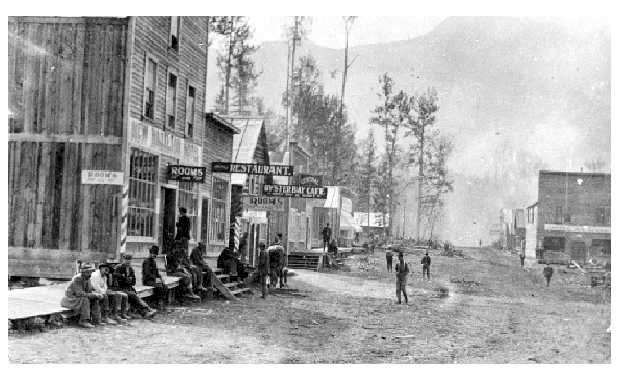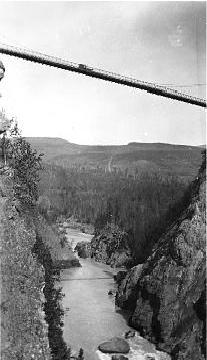|
Witset
Witset (formerly Moricetown) is a Wet'suwet'en village in Central British Columbia, Canada on the west side of the Bulkley River on Coryatsaqua (Moricetown) Indian Reserve No. 2, and on Moricetown Indian Reserve No.1. The current village was built during the early 1900s. Evidence of inhabitants date back to around 5,500 years ago. Name The original name of the village was Witset. It was abandoned after a rockslide that prevented salmon from reaching the canyon. Witsuwit'en people then settled in Tsë Cakh (Hagwilget) and referred to the old village as Këyikh Wigit (often spelled Kyah Wiget). It was renamed after the pioneer missionary Father Adrien-Gabriel Morice, who named the village after himself, and was admonished by the church for doing so. [...More Info...] [...Related Items...] OR: [Wikipedia] [Google] [Baidu] |
Houston, British Columbia
Houston ( ) is a forestry, mining and tourism town in the Bulkley Valley of the Northern Interior of British Columbia, Canada. Its urban population is approximately 3600 people, with approximately 2000 in the surrounding rural area. It is known as the "steelhead capital" and it has the world's largest fly fishing rod. Houston's tourism industry is largely based on ecotourism and Steelhead Park, situated along Highway 16. Houston is named in honour of the pioneer newspaperman John Houston. History The Morice area was first charted by amateur historian, cartographer and geologist, Reverend Adrien-Gabriel Morice (1859-1938) known to northern British Columbian locals as "Father Morice." In 1880, Morice came to British Columbia as a Catholic missionary to the native people and was one of the first 'white men' to see most of the area. Morice wrote, ''The History of the Northern Interior of British Columbia (formerly New Caledonia) 660 to 1880'. The Indigenous people were initia ... [...More Info...] [...Related Items...] OR: [Wikipedia] [Google] [Baidu] |
Adrien-Gabriel Morice
Adrien-Gabriel Morice (27 August 1859 – 21 April 1939) was a missionary priest belonging to the Oblates of Mary Immaculate. He served as a missionary in Canada, and created a writing system for the Carrier language. Early life Father Morice was born and raised in France, in the commune of Saint-Mars-sur-Colmont in the département of Mayenne. As a seminarian he was inspired by Father Émile Petitot and set himself the goal of becoming a missionary and explorer in Northwestern Canada. He arrived in British Columbia in 1880, and after a stint in Williams Lake at St. Joseph's school, where he studied Chilcotin and, with the aid of Jimmy Alexander, the son of a Carrier woman and a fur trader who was sent to St. Joseph's School, began his study of Carrier. Work with aboriginal languages In 1885 his dreams were realized and he was posted to Fort St. James, the fur trading and missionary center in the Carrier region. Father Morice rapidly learned the Carrier language and became the ... [...More Info...] [...Related Items...] OR: [Wikipedia] [Google] [Baidu] |
Smithers, British Columbia
Smithers is a town in northwestern British Columbia, approximately halfway between Prince George and Prince Rupert. With a population of 5,351 in 2016, Smithers provides service coverage for most of the Bulkley Valley. History Region First Nations settlements existed thousands of years prior to European presence. Railway The planned Grand Trunk Pacific Railway (GTP) required two major divisional points in BC, where additional staff and facilities would be located. After Prince George, various central points on the Prince Rupert leg were considered in the vicinity of Aldermere. A prime choice was Hubert, east of Telkwa, initially called Bulkley by the developers, who had amassed the surrounding land. These speculators promoted a future new city, and later a trade centre of the Bulkley Valley, both fallacious claims, since Smithers had already been selected as the divisional point. The Interior News of Aldermere had earlier adopted a policy of refusing advertising from such unsc ... [...More Info...] [...Related Items...] OR: [Wikipedia] [Google] [Baidu] |
New Hazelton
New Hazelton is a district municipality on Highway 16 in northwest British Columbia, Canada. It is situated northeast of Terrace and northwest of Smithers and in 2016 had a population of 580 people, a decrease of 12.9% comparing to 2011. New Hazelton is one of the "Three Hazeltons", the other two being the original "Old" Hazelton located to the northwest very near to the confluence of the Skeena and Bulkley Rivers and South Hazelton, to the west. Demographics In the 2021 Census of Population conducted by Statistics Canada, New Hazelton had a population of 602 living in 266 of its 305 total private dwellings, a change of from its 2016 population of 580. With a land area of , it had a population density of in 2021. Economy New Hazelton is the service and commerce center for the Kispiox Valley, which includes several first nation communities as well as residents of South Hazelton and Old Hazelton. The population of this area is approximately 6500 people. Due to its l ... [...More Info...] [...Related Items...] OR: [Wikipedia] [Google] [Baidu] |
New Hazelton, British Columbia
New Hazelton is a district municipality on Highway 16 in northwest British Columbia, Canada. It is situated northeast of Terrace and northwest of Smithers and in 2016 had a population of 580 people, a decrease of 12.9% comparing to 2011. New Hazelton is one of the "Three Hazeltons", the other two being the original "Old" Hazelton located to the northwest very near to the confluence of the Skeena and Bulkley Rivers and South Hazelton, to the west. Demographics In the 2021 Census of Population conducted by Statistics Canada, New Hazelton had a population of 602 living in 266 of its 305 total private dwellings, a change of from its 2016 population of 580. With a land area of , it had a population density of in 2021. Economy New Hazelton is the service and commerce center for the Kispiox Valley, which includes several first nation communities as well as residents of South Hazelton and Old Hazelton. The population of this area is approximately 6500 people. Due to its lo ... [...More Info...] [...Related Items...] OR: [Wikipedia] [Google] [Baidu] |
Hagwilget Village
Hagwilget or Hagwilgyet is a First Nations reserve community of the Wet'suwet'en people located on the lower Bulkley River just east of Hazelton in northwestern British Columbia, Canada. The community's name means "well-dressed" as in "ostentatious," though another meaning is "the quiet people". It has also been spelled Awillgate and Ackwilgate and it has also been named Rocher Déboulé - "falling rock" - a reference to a landslide in this area from Rocher Déboulé Mountain, which blocked salmon runs on the Bulkley River at this location. *Hagwilget Canyon *Hagwilget Canyon Bridge Hagwilget Canyon Bridge is a suspension bridge over the Hagwilget Canyon on the Bulkley River, at the Wet'suwet'en village of Hagwilget, British Columbia. The current bridge was constructed in 1931, and later reinforced in 1990. Three previous ... References BC Names listing "Hagwilget" (community) Bulkley Valley Skeena Country Wet'suwet'en {{cariboo-geo-stub ... [...More Info...] [...Related Items...] OR: [Wikipedia] [Google] [Baidu] |
Burns Lake Indian Band
Tsʼil Kaz Koh First Nation or the Burns Lake Indian Band is a Wetsuweten band government whose main community is located on Burns Lake, near the divide between the Bulkley and Nechako River basins, approximately 220 km west of Prince George, British Columbia, Canada. Tsʼil Kaz Koh as a name is derived from the Carrier name for the creek that runs through the area. The band has four reserves, totalling about 184.6 hectares, and as of August 2007, they had 114 band members. As of 2013, the Burns Lake Band has about 129 members on and off reserve. Tsʼil Kaz Koh is a member of the Carrier Sekani Tribal Council The Carrier Sekani Tribal Council (familiarly known as CSTC) is a tribal council representing six First Nations in the Central Interior of British Columbia. It was originally known as the ''Lakes District Tribal Council''. The CSTC was incorporat .... The Burns Lake Band offices are located at 653 Highway 16 west in Burns Lake, BC. Chief and Council One chief a ... [...More Info...] [...Related Items...] OR: [Wikipedia] [Google] [Baidu] |
Royal Canadian Mounted Police
The Royal Canadian Mounted Police (RCMP; french: Gendarmerie royale du Canada; french: GRC, label=none), commonly known in English as the Mounties (and colloquially in French as ) is the federal police, federal and national police service of Canada. As police services are the constitutional responsibility of provinces and territories of Canada, the RCMP's primary responsibility is the enforcement of federal criminal law, and sworn members of the RCMP have jurisdiction as a Law enforcement officer, peace officer in all provinces and territories of Canada.Royal Canadian Mounted Police Act', RSC 1985, c R-10, s 11.1. However, the service also provides police services under contract to eight of Canada's Provinces and territories of Canada#Provinces, provinces (all except Ontario and Quebec), all three of Canada's Provinces and territories of Canada#Territories, territories, more than 150 municipalities, and 600 Indigenous peoples in Canada, Indigenous communities. In addition to en ... [...More Info...] [...Related Items...] OR: [Wikipedia] [Google] [Baidu] |
Office Of The Hereditary Chiefs
An office is a space where an organization's employees perform administrative work in order to support and realize objects and goals of the organization. The word "office" may also denote a position within an organization with specific duties attached to it (see officer, office-holder, official); the latter is in fact an earlier usage, office as place originally referring to the location of one's duty. When used as an adjective, the term "office" may refer to business-related tasks. In law, a company or organization has offices in any place where it has an official presence, even if that presence consists of (for example) a storage silo rather than an establishment with desk-and-chair. An office is also an architectural and design phenomenon: ranging from a small office such as a bench in the corner of a small business of extremely small size (see small office/home office), through entire floors of buildings, up to and including massive buildings dedicated entirely to one c ... [...More Info...] [...Related Items...] OR: [Wikipedia] [Google] [Baidu] |
British Columbia Treaty Process
The British Columbia Treaty Process (BCTP) is a land claims negotiation process started in 1993 to resolve outstanding issues, including claims to un-extinguished indigenous rights, with British Columbia's First Nations. Two treaties have been implemented under the BCTP. The Nisga'a Treaty is considered separate from the Treaty Process because those negotiations began before the BC treaty process was started, and it has been called a blueprint for the current process. To represent the interests of First Nations involved with the process, the First Nations Summit was created. There are officially 60% of First Nations bands in the process, but only 20% are said to be making progress. About 40% of First Nations are not involved in the treaty process. History Previous negotiations Because the Royal Proclamation of 1763 stated that the Crown must negotiate and sign treaties with the Indigenous people before land could be ceded to a colony, the Numbered Treaties were negotiated in mo ... [...More Info...] [...Related Items...] OR: [Wikipedia] [Google] [Baidu] |




